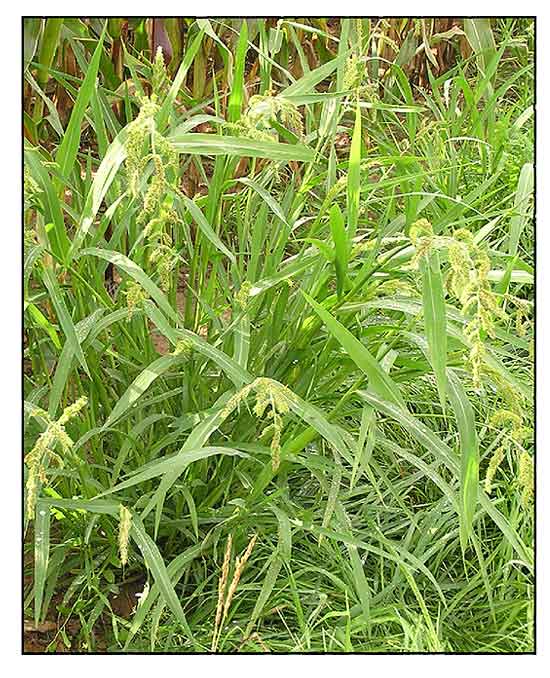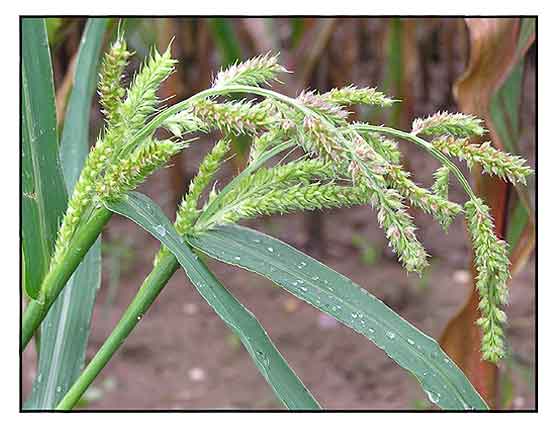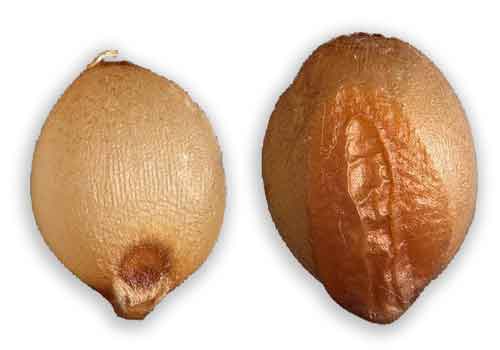 Gen info Gen info
- Considered one of the world's worse weeds. It reduces crop yields and causes forage crops to fail by removing up to 80% of available soil nitrogen. Individual plants can produce up to 40,000 seeds a year, its dispersion facilitated water, birds, insects, machineries, and animal feet. (3)
- A serious threatening weed of lowland rice due to rapid and competitive growth.
- E. crus-galli was domesticated in southern Hokkaido 4,500 years ago.
Botany
• Echinochloa crus-galli is a robust annual, tufted grass with erect or geniculate culms, up to 1.5 tall, often rooting and branching near the base. Leaf-sheath 9-13 cm long, glabrous or hairy; ligule absent; leaf-blade linear-acuminate, 5-50 cm × 0.5-2 cm, glabrous. Inflorescence erect or nodding, 6-22 cm long, green- or purple-tinged, composed of 9-12 racemes, 2-4(-10) cm long and sometimes branched; racemes untidily 2-several-rowed, hispidulous on the back, scaberulous on the margins; spikelets crowded, hispid, ovoid-ellipsoid, 3-4 mm long excluding the awns; lower floret barren with lemma acuminate or awned, awn up to 0.5-1(-5) cm long; upper lemma pointed, shiny. Caryopsis ovoid, 2-3 mm long, brownish, dorsally flattened, with longitudinal ridges on the convex surface. (1)
 • Polymorphous, coarse, tufted annual, tall and often weedy; culms erect to decumbent, 0.8–1.5 m tall, rather thick, branching at base. Leaves flat, glabrous, elongate, 30–50 cm long, 1–2 cm broad, scabrous, slightly thickened at margin; ligules absent; sheaths smooth, lower ones often reddish; panicle 8–30 cm long, green or purple, exerted, somewhat nodding, densely branched, the branches to 5 cm long, erect or ascending sessile. Spikelets 3–4 mm long, densely arranged on branches, ovoid, often long-awned, pale green to dull purple, short-bristly along veins; racemes spreading, ascending or appressed, the lower somewhat distant, as much as 10 cm long, sometimes branched; glumes and lower lemma minutely hairy on surface with longer more rigid hairs on veins; first glume about two-fifths as long as spikelet, deltoid, the second as long as the spikelet, short-awned; sterile lemma membranous, with a straight scabrous awn, 2–4 cm long or awnless; fertile lemma ovate-elliptic, acute, pale yellow, lustrous, smooth, 3–3.5 mm long. Fl. Aug.–Oct.; seed maturing Sept.–Oct., up to 40,000/plant. Var. crus-galli has long, somewhat spreading papillose cilia at the summits of the internodes and bases of the branches in the inflorescence and short, very thick papillose cilia along the lateral nerves of the 2nd glume, sterile lemma, and somewhat spreading spikes", and sterile lemmas with awns 0–10 mm long. (3) • Polymorphous, coarse, tufted annual, tall and often weedy; culms erect to decumbent, 0.8–1.5 m tall, rather thick, branching at base. Leaves flat, glabrous, elongate, 30–50 cm long, 1–2 cm broad, scabrous, slightly thickened at margin; ligules absent; sheaths smooth, lower ones often reddish; panicle 8–30 cm long, green or purple, exerted, somewhat nodding, densely branched, the branches to 5 cm long, erect or ascending sessile. Spikelets 3–4 mm long, densely arranged on branches, ovoid, often long-awned, pale green to dull purple, short-bristly along veins; racemes spreading, ascending or appressed, the lower somewhat distant, as much as 10 cm long, sometimes branched; glumes and lower lemma minutely hairy on surface with longer more rigid hairs on veins; first glume about two-fifths as long as spikelet, deltoid, the second as long as the spikelet, short-awned; sterile lemma membranous, with a straight scabrous awn, 2–4 cm long or awnless; fertile lemma ovate-elliptic, acute, pale yellow, lustrous, smooth, 3–3.5 mm long. Fl. Aug.–Oct.; seed maturing Sept.–Oct., up to 40,000/plant. Var. crus-galli has long, somewhat spreading papillose cilia at the summits of the internodes and bases of the branches in the inflorescence and short, very thick papillose cilia along the lateral nerves of the 2nd glume, sterile lemma, and somewhat spreading spikes", and sterile lemmas with awns 0–10 mm long. (3)
Distribution
- Native to the Philippines.
- Adapted to wet places and waterlogged land. Grows vigorously in hot wet conditions from sea level to 2500 m altitude.
- Native range is S. & E. Europe to Asia, W., E. & S. Tropical Africa to S. Africa, Madagascar. (4)
- Invades riverbanks and shores of lakes and ponds, along roadsides, ditches, railway lines, and indisturbed areas such as gravel pits and dumps.
(3)
 Constituents Constituents
- Nutrient analysis in grams (g) or milligrams (mg) per 100 g of leaves (dry weight): 0 calories per 100 g; water 0%; protein 7.4g; fat 2.9g; carbohydrate 81.1g; fiber 31.3g; ash 8.6g; with no vitamin and minerals.
- Preliminary phytochemical studies reveal presence of alkaloids, glycosides, carbohydrates, flavonoids, phytosterols/terpenes, proteins, and saponins. (5)
- Nutritional analysis of grains per 100g yielded: protein 9.0-13.7% protein, 2.3-3.5% fat, 63.8-9.9% carbohydrates, 5.2-29.9% fiber, 310-364 kcal, 8 mg/100g calcium, 2.9 mg iron, 0.41 mg thiamin, 0.28 mg riboflavin, 4.5 mg/100g niacin. (5)
- Amino acid analysis revealed alanine, arginine, asparagines, aspartic acid, glutamic acid, glutamine, glycine, histidine, isoleucine, leucine, lysine, methionine, phenylalanine, proline, serine, threonine, tryptophan, tyrosine, valine and gamma amino butyric acid. (5)
- Chemical composition of grains with and without husk yielded: moisture (10.7 and 12.2), protein (8.7 and 11.7), lipids 6.7 and 4.9, ash 7.8 and 1.5, dietary fiber 40.8 and 3.1 (soluble 3.3 and 0.8, insoluble 37.5 and 2.3), other carbohydrates 25.3 and 66.6. (7)
- Study of fatty acids in form of methyl esters in oil of barnyard grains without husk yielded: linoleic acid 61.03%, oleic acid 22.88%, palmitic acid 13.01%
, linolenic acid 1.47%, stearic 1.00%, arachidic 0.22, lignoceric 0.18%, palmitoleic 0.17%, myristic acid 0.06%. Caprylic, capric, lauric, behenic acid, erucic acids were not detected. (7)
- Chromatographic separations of chloroform and ethyl acetate fractions yielded pure phenolic compounds (1-8) identified as 5,7-dihydroxy-3′,4′,5′-trimethoxy flavone (1), 5,7,4′-trihydroxy-3′,5′-dimethoxy flavone (tricin) (2), quercetin (3), flavone (4), apigenin-8-C-sophoroside (5), 2-methoxy-4-hydroxy cinnamic acid (6), p-coumaric acid (7) and quercetin-3-0-glucoside (8). (see study below) (8)
Properties
- As a weed in rice, fertilizer applications favor the growth of E. crus-gallii more than the rice crop. Rice yields can be severely reduced, especially when more than 20 plants/m2 are present. (1)
- Studies have suggested antioxidant, antidiabetic, anticancer properties.
Parts used
Roots, grains.
Uses
Edibility
- Grain of some varieties eaten by humans in times of scarcity. Sometimes used for adulterating fennel.
- Young shoots eaten as vegetable.
- Seeds are edible, cooked, with a somewhat bitter flavor.
- In Hisar the seeds are commonly eaten with cultivated rice grains to make rice pudding or khir on Hindu fast days.
Folkloric
- In the Philippines, roots are boiled to treat indigestion.
- In India, used as folk remedy for carbuncles, hemorrhages, sores, spleen problems, cancer, and wounds. (3)
- In Korea, considered to effectively lower blood sugar and cholesterol. (3)
Others
- Fodder: Upper parts of stem above water are cut and carried to feed animals. It is relished by cattle and water buffaloes. In paddy fields where it is the main species, yields of 4-11st/ha of green material are obtained. (1)
Studies
• Antidiabetic / Antioxidant / Grains: Study evaluated a 70% hydroalcoholic extract of E. crus-galli grains for antidiabetic activity in normal and alloxan-induced diabetic rats. Glibencladmide was used as standard reference. Oral glucose tolerance test at 400 and 200 mg/kg p.o. showed significant reduction in fasting blood glucose, serum cholesterol and triglycerides, LDL-C and VLDL-C, along with a significant increase in HDL-C, hemoglobin, body weight and liver weight and improved levels of antioxidant levels, TBARS. GSH, and SOD. (6)
• Comparative Phytochemicals and Antioxidant Activity / Grains With and Without Husks: Study showed grains with husk presented with higher content of lipids 6.7%, minerals 7.8%, dietary fibers 40.8%, total phenolic compounds 399 mg equiv. catechin/100 g, and antioxidant activity as compared to grains without husk. Results suggest a promising source of nutrients for human or animal nutrition. (see constituents above) (7)
• Cytotoxicity Against Human Cancer Cell Lines / Grains: The sulforhodamine B assay evaluated the cytotoxicity of E. crus-galli grains against four human cancer cell lines. The ethanolic extract (70%) showed to be most active against HCT-116 and HeLa cell lines with IC50s of 11.2 and 12.0 µg/ml, respectively. Chloroform and ethyl acetate fractions exhibited highest activities against HCT-116 cell lines. Chromatographic separations of chloroform and ethyl acetate fractions yielded pure phenolic compounds (1-8). All isolated phenolic compounds exhibited varying significant activities against the four human cancer cell lines where methoxylated flavones (1 and 2) were most active, comparable to anticancer drug Doxorubicin®. (see constituents above) (8)
Availability
Wild-crafted. |

![]()




 • Polymorphous, coarse, tufted annual, tall and often weedy; culms erect to decumbent, 0.8–1.5 m tall, rather thick, branching at base. Leaves flat, glabrous, elongate, 30–50 cm long, 1–2 cm broad, scabrous, slightly thickened at margin; ligules absent; sheaths smooth, lower ones often reddish; panicle 8–30 cm long, green or purple, exerted, somewhat nodding, densely branched, the branches to 5 cm long, erect or ascending sessile. Spikelets 3–4 mm long, densely arranged on branches, ovoid, often long-awned, pale green to dull purple, short-bristly along veins; racemes spreading, ascending or appressed, the lower somewhat distant, as much as 10 cm long, sometimes branched; glumes and lower lemma minutely hairy on surface with longer more rigid hairs on veins; first glume about two-fifths as long as spikelet, deltoid, the second as long as the spikelet, short-awned; sterile lemma membranous, with a straight scabrous awn, 2–4 cm long or awnless; fertile lemma ovate-elliptic, acute, pale yellow, lustrous, smooth, 3–3.5 mm long. Fl. Aug.–Oct.; seed maturing Sept.–Oct., up to 40,000/plant. Var. crus-galli has long, somewhat spreading papillose cilia at the summits of the internodes and bases of the branches in the inflorescence and short, very thick papillose cilia along the lateral nerves of the 2nd glume, sterile lemma, and somewhat spreading spikes", and sterile lemmas with awns 0–10 mm long. (
• Polymorphous, coarse, tufted annual, tall and often weedy; culms erect to decumbent, 0.8–1.5 m tall, rather thick, branching at base. Leaves flat, glabrous, elongate, 30–50 cm long, 1–2 cm broad, scabrous, slightly thickened at margin; ligules absent; sheaths smooth, lower ones often reddish; panicle 8–30 cm long, green or purple, exerted, somewhat nodding, densely branched, the branches to 5 cm long, erect or ascending sessile. Spikelets 3–4 mm long, densely arranged on branches, ovoid, often long-awned, pale green to dull purple, short-bristly along veins; racemes spreading, ascending or appressed, the lower somewhat distant, as much as 10 cm long, sometimes branched; glumes and lower lemma minutely hairy on surface with longer more rigid hairs on veins; first glume about two-fifths as long as spikelet, deltoid, the second as long as the spikelet, short-awned; sterile lemma membranous, with a straight scabrous awn, 2–4 cm long or awnless; fertile lemma ovate-elliptic, acute, pale yellow, lustrous, smooth, 3–3.5 mm long. Fl. Aug.–Oct.; seed maturing Sept.–Oct., up to 40,000/plant. Var. crus-galli has long, somewhat spreading papillose cilia at the summits of the internodes and bases of the branches in the inflorescence and short, very thick papillose cilia along the lateral nerves of the 2nd glume, sterile lemma, and somewhat spreading spikes", and sterile lemmas with awns 0–10 mm long. (
